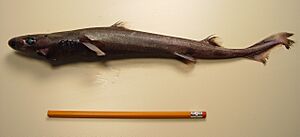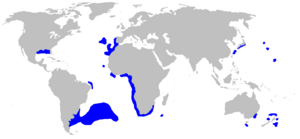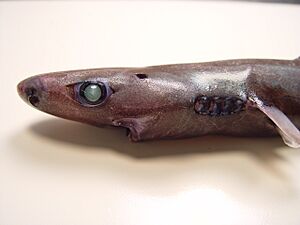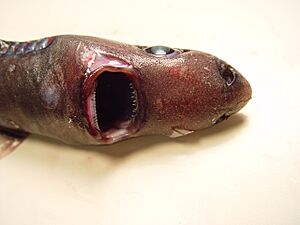Smooth lanternshark facts for kids
Quick facts for kids Smooth lanternshark |
|
|---|---|
 |
|
| Conservation status | |
| Scientific classification | |
| Genus: |
Etmopterus
|
| Species: |
pusillus
|
 |
|
| Range of the smooth lanternshark | |
| Synonyms | |
|
Acanthidium pusillum Lowe, 1839 |
|
The smooth lanternshark (Etmopterus pusillus) is a type of dogfish shark. It is also sometimes called the slender lanternshark. These sharks live in many parts of the Atlantic and Pacific Oceans.
They can be found deep in the ocean, both near the bottom (called a benthic environment) at depths of 274 to 1,000 meters (900 to 3,300 feet), and in the open water (called a pelagic environment) from the surface down to 708 meters (2,300 feet). The smooth lanternshark is related to the larger blurred lanternshark. Both are special because of their unique skin, which has tiny, rough scales called dermal denticles.
This shark has a slim, dark brown body. It has a faint black stripe on its sides near its back fins. Smooth lanternsharks can grow up to 50 centimeters (20 inches) long. They grow slowly and give birth to live young. They eat smaller squid, fish, and fish eggs. Sometimes, smooth lanternsharks are accidentally caught by fishing boats. However, the International Union for Conservation of Nature (IUCN) says they are not currently in danger.
Contents
About the Smooth Lanternshark
The smooth lanternshark was first described by a British scientist named Richard Thomas Lowe in 1839. He gave it the scientific name Acanthidium pusillum. Later, it was moved into the group of sharks called Etmopterus. The word pusillus means "weak" in Latin.
This shark is part of a special group with the blurred lanternshark. What makes them unique are their dermal denticles. These are like tiny teeth on their skin. For these two sharks, the denticles are arranged unevenly and have flat tops, almost like they were cut off.
Where They Live
Smooth lanternsharks live in many places around the world. In the Atlantic Ocean, you can find them from the Gulf of Mexico all the way to Argentina. They also live from Portugal to South Africa, including places like Cape Verde and the Azores. They are even found near the Mid-Atlantic Ridge.
In the Indian Ocean, they are seen off the coast of KwaZulu-Natal and Madagascar. In the Pacific Ocean, they live from the East China Sea to southern Japan. They are also found near the Hawaiian–Emperor seamount chain, off Australia and New Zealand, and near the Nazca Plate.
These sharks usually stay near the ocean floor. They live on the edges of continents and islands, called continental and insular shelves and slopes. They are found at depths of 274 to 1,000 meters (900 to 3,300 feet). Sometimes, they might go even deeper, up to 1,998 meters (6,555 feet).
Near southern Portugal, they seem to prefer rocky areas. They might also move up and down in the water during the day and night. In the South Atlantic, they can also live in the open ocean, from the surface down to 708 meters (2,300 feet). They have even been seen swimming near hydrothermal vents, which are hot springs on the ocean floor.
What They Look Like
The smooth lanternshark has a light body and a large head. Its snout is pointed, and it has big, oval eyes. Its nostrils have small flaps of skin in front.
Inside its mouth, it has many rows of teeth. The upper jaw has 22 to 31 rows, and the lower jaw has 30 to 53 rows. Each upper tooth has a sharp point in the middle with one or two tiny points on the sides. Older male sharks grow even more side points on their upper teeth. The lower teeth are smooth and sharp, like knives. They fit together to make a continuous cutting edge. This shark also has five long pairs of gill slits.
It has two dorsal fins on its back. The first dorsal fin has a strong spine in front of it. The second dorsal fin is much bigger than the first and has a longer spine. Its pelvic fins are low and angled. Unlike some other fish, it does not have an anal fin. Its tail fin, called the caudal fin, is short and wide.
The shark's skin feels smooth because its tiny, blocky dermal denticles are spread out and not in neat rows. It is a dark brown color all over. It has a faint black mark above its pelvic fins that extends a bit forward and backward. The smooth lanternshark looks a lot like the blurry lanternshark, but it is smaller. The main way to tell them apart is by counting the turns in their intestines. The smooth lanternshark has 10 to 13 turns, while the blurry lanternshark has 16 to 19.
Reproduction and Life Cycle
Smooth lanternsharks eat squid, lanternfishes, smaller dogfish sharks, and fish eggs. They also eat crustaceans and other fish.
These sharks are ovoviviparous. This means the mother carries the eggs inside her body until they hatch. The young sharks get their food from a yolk sac while they are developing. On average, females give birth to about 10 young sharks at a time.
Male sharks are ready to reproduce when they are about 31 to 39 centimeters (12 to 15 inches) long. Females are ready when they are about 38 to 47 centimeters (15 to 18 inches) long. The size at which they become mature can be different depending on where they live. For example, sharks in the western Atlantic mature at a larger size than those off KwaZulu-Natal.
These sharks grow slowly. As they get older, their bodies become longer. Off southern Portugal, males can live for at least 13 years, and females can live for at least 17 years.
Smooth Lanternsharks and People
Many smooth lanternsharks are caught by accident. This often happens in commercial fisheries that use longlines, which are very long fishing lines with many hooks. They are also sometimes caught in bottom trawls (nets dragged along the seafloor) and fixed bottom nets. This happens a lot in the eastern Atlantic and off the coast of Japan.
In deepwater fisheries near southern Portugal, the smooth lanternshark is one of the most common sharks caught by accident. Most of these sharks are thrown back into the ocean. However, some are dried and salted to be eaten, or made into fishmeal for animal feed.
Because smooth lanternsharks grow and reproduce slowly, they could be at risk if too many are caught. But right now, fishing numbers don't show that their population is shrinking. Also, because they live in so many different places, the IUCN says they are of Least Concern. This means they are not currently considered endangered.
In June 2018, the New Zealand Department of Conservation listed the smooth lanternshark as "At Risk – Naturally Uncommon." This means they are not very common in New Zealand waters. They also added notes saying "Data Poor" (meaning not enough information) and "Secure Overseas" (meaning they are doing fine in other parts of the world).





